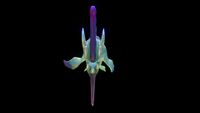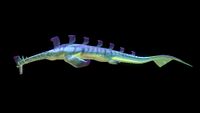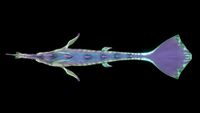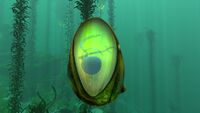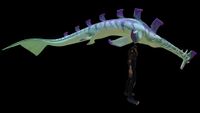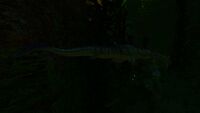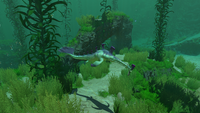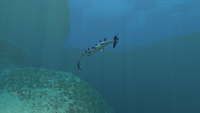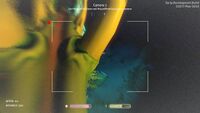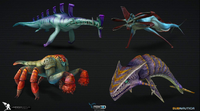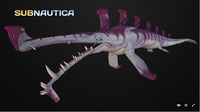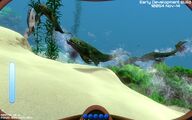Stalker

|
This seems new This article contains information that is updated for the latest Experimental Version of Subnautica. Players using stable mode may find this information inaccurate. |
Template:Class 2 FaunaThe Stalker is an aggressive fauna species mostly found populating the Kelp Forest, while it can also be found around the Aurora in the Crash Zone.
Occasionally, Stalkers can be found swimming into the Safe Shallows while chasing Peepers or other small fauna.
Appearance
The Stalker is a rather large creature, possessing an elongated, fusiform body with smooth skin. Its head features a long snout greatly resembling that of real life gharials.
On its back protrude seven dorsal plates running along from neck to tail, as well as two pectoral and pelvic, purple-tipped fins on each side, and ends with a broad, fluked tail.
The Stalker's dorsal side is blue-gray in color and patterned in dark blue and purple, with a bright green and aqua underside.
Behavior
The Stalker seems to have a fondness for a metal; it will approach the metal objects such as Metal Salvage, Silver Ore and Titanium pick it up with its mouth and start flailing it around for a while. Doing so will not only displace the item, but will sometimes leave behind a Stalker Tooth. Stalker teeth will also sometimes drop when a Stalker attempts to attack a Seamoth, or grabs a Camera Drone. These teeth are required for creating Enameled Glass, which is needed to make a Cyclops and other useful items. Stalkers will sometimes place metal salvage in a certain area with other pieces.
Being predators, Stalkers will attempt to chase and eat nearby Peepers and other small prey. They will also attack the player upon close encounters, with each bite dealing 30 damage. The player should be cautious while exploring Kelp Forests to avoid getting attacked by surprise, as Stalkers often form small groups that will lurk in the dense Creepvines.
At night, beside being more difficult to spot due to being one of only two non-bioluminescent creatures in the game, Stalkers become more aggressive and have a wider aggressive radius, so it is advised to avoid swimming near Kelp Forests at night without adequate protection.
Stalkers can be found guarding or lurking near their eggs, and will attack if the player gets too close.
Stalkers can grab Camera Drones, including ones housed in their sockets on the Scanner Room and will carry them in their mouth similarly to Metal Salvage. During this time the drones are incapacitated and can be taken out of their maximum range, rendering them unusable.
Stalkers will also collect ores, should the player drop it near them.
|
Spoiler alert: The following section contains story related material. |
|---|
|
The Stalkers inside Primary Containment Facility's Aquarium are not hostile to the player, and are thus not a threat. |
Interactions with the Player
It is possible to temporarily placate a Stalker by feeding them any kind of catchable fish, or by giving them metal salvage. Doing any of the above will pacify the creature for a short while.
After being fed, the Stalker will not only become peaceful towards the player, but it will also start looking for metal salvage, pick it up, and drop it at the player's position as a gift. This behavior can also be extended the more fish the player feeds it.
Keep in mind that this "tamed" behavior is only temporary. The period of submission can be extended by offering the predator more fish or salvage.
Energy Value
Data Bank Entry
|
A streamline predator with developed intelligence and strength. Encountered in the kelp forests, in wait of prey leaving the safety of the shallows.
Prey: Peepers and other small herbivores Assessment: Tame or avoid - Further research required |
Gallery
<tabber> Screenshots=
|-| Concept Art=
Carar concept art, featuring Stalkers
|-| Other=
Model from Sketchfab
The Stalker's old model - the Lava Lizard
</tabber>
Trivia
- As of 14.12.2014 the model of the Stalker was changed. Until then, the model of the Lava Lizard was used.[1]
- The Stalker was also listed as Snout Shark in development documents.[2]
- Stalkers and Lava Lizards are currently the only implemented creatures that do not have some degree of bioluminescence.
References
- ↑ http://forums.unknownworlds.com/discussion/136215/what-is-the-name-of-the-new-creature-in-the-kelp-field Dated December 2014.
- ↑ https://trello.com/c/egknl2CS/3236-snout-shark-export Dated December 22, 2014.
Lua error in package.lua at line 80: module 'Dev:Navbox' not found.






